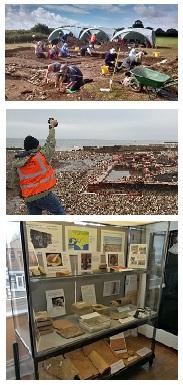
In 2006, Chichester and District Archaeology Society became involved in the Chichester Harbour Conservancy Condition Assessment project. The objective of this project was to monitor the condition of monuments of historic interest within the Chichester Harbour Area of Outstanding Natural Beauty. One of the sites involved was the Warblington Roman villa, which had been discovered by a Dr Gedge in the 1920s.
The villa site is situated between Havant and Emsworth just south of the supposed Chichester (Noviomagnus Regnorum) to Bitterne (Clausentum) Roman Road. Within a few kilometres there is a villa at Langstone, Havant, the temple complex on Hayling Island and some form of settlement on Thorney. The main road that ran East West and the lesser road that ran North South through Havant along with Chichester and Langstone harbours mean that it would have been a busy location. Fishbourne, Chichester and Portchester are not far away.
Since 2006 the Chichester and District Archaeology Society (CDAS), with support from the Chichester Harbour Conservancy, has been undertaking a programme of research and field work. A full range of geophysical surveys have been undertaken, which revealed not only the presence of a winged corridor villa but also a number of other features.
Excavations have shown that only the foundations of buildings remain. Three buildings have been investigated so far:
These buildings are grouped so as to form three sides of a rectangle. There are probably other buildings, yet to be identified. Pottery evidence shows occupation in the immediate area from the late Iron Age through to the 4th century AD.
During the 2014 excavation a rare and fascinating stone cist containing lead packages was found. You can read the full report about it here. The cist is now on display in the Emsworth museum.